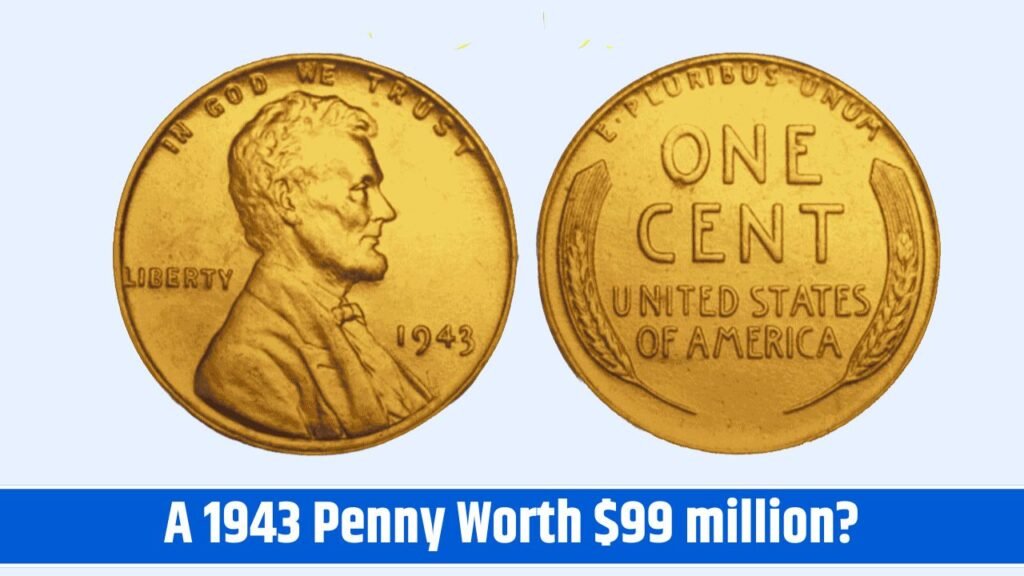Imagine digging through your loose change and finding a penny that could be worth $99 million. It sounds like a fantasy, but one rare version of the 1943 Lincoln Wheat Penny has gained legendary status in the coin-collecting world. Though the $99 million figure may be an internet exaggeration, this penny’s true story is fascinating—rooted in a rare World War II minting error and the enduring legacy of American resilience.
Let’s dive into what makes this penny so special, how to spot one, and why it’s still turning heads decades later.
The 1943 Lincoln Wheat Penny
The Lincoln Wheat Penny, minted from 1909 to 1958, features two wheat ears on the reverse and Abraham Lincoln’s profile on the front. While most are worth only face value, certain rare versions—especially from 1943—are worth a fortune.
That year, the U.S. Mint switched from copper to zinc-coated steel to conserve copper for wartime ammunition. However, a few copper planchets (coin blanks) from 1942 were mistakenly used in the presses in early 1943. These rare copper versions are what collectors are desperately searching for today.
Only 10 to 20 authentic 1943 copper pennies are known to exist across all mints, making them one of the rarest coins in American history.
What Makes the 1943 Copper Penny So Valuable?
The sky-high value is driven by three powerful factors:
- Minting Error: The switch to steel was intentional, but a few copper blanks accidentally made it through production.
- Extreme Rarity: Fewer than two dozen are known to exist, with some still potentially undiscovered.
- Historical Context: Produced during World War II, the coin represents a tangible link to a pivotal moment in U.S. history.
While the “$99 million” valuation is most likely viral exaggeration, real auction results confirm that these coins have sold for over $1 million, with potential for more depending on condition and provenance.
Quick Facts
| Feature | Details |
|---|---|
| Year | 1943 |
| Material | Copper (error—should be steel) |
| Mint Location | Mostly Philadelphia (no mint mark) |
| Estimated Quantity | 10–20 known |
| Top Sale Price | Over $1 million at auction |
| Potential Value | Up to $99 million (rumored, not verified) |
How to Check If You Have a Rare 1943 Penny
It might be sitting in your change jar or piggy bank. Here’s how to tell if you’ve struck coin gold:
Check the Date
Only 1943-dated pennies made of copper are rare. If it’s any other year—or if it’s steel—it’s likely common.
Use a Magnet
Steel pennies will stick to a magnet. Copper won’t. This is the quickest way to weed out ordinary coins.
Color Check
Steel coins are silvery-gray. Copper coins have a reddish-brown hue.
Weigh It
Steel pennies weigh about 2.7 grams. Copper pennies weigh around 3.11 grams. Use a digital gram scale for accuracy.
Other Rare Lincoln Pennies That Can Be Valuable
Even if you don’t find the fabled 1943 copper penny, there are other Lincoln Wheat Pennies that are worth collecting:
| Coin | Est. Value (High Grade) |
|---|---|
| 1909-S VDB | Up to $100,000 |
| 1914-D | $10,000+ |
| 1922 “No D” | $1,000–$10,000 |
| 1955 Doubled Die | $1,500–$15,000 |
These coins are prized for low mintage, minting errors, or both.
What If You Think You Found One?
If your 1943 penny passes the magnet and color tests, don’t clean it or handle it excessively. Have it examined by a certified grading service such as:
- PCGS (Professional Coin Grading Service)
- NGC (Numismatic Guaranty Company)
They can confirm authenticity, assign a grade, and seal the coin for protection and resale.
Why This Coin Still Matters
Beyond its monetary value, the 1943 copper Lincoln Wheat Penny is a symbol of a nation at war, adapting even its currency to serve a greater cause. It represents history you can hold in your hand—proof that sometimes, even the smallest items can have the biggest stories.
So the next time you dig through your spare change, don’t overlook those old pennies. That worn copper coin might just be worth a fortune—and a chapter of history.
FAQs
Is any 1943 penny valuable?
Most 1943 pennies are steel and worth only a few cents to a dollar. Only copper versions are extremely valuable.
How can I tell if I have a copper or steel 1943 penny?
Use a magnet. Steel sticks; copper doesn’t. Also, copper has a warm, brown color compared to steel’s silver shine.

